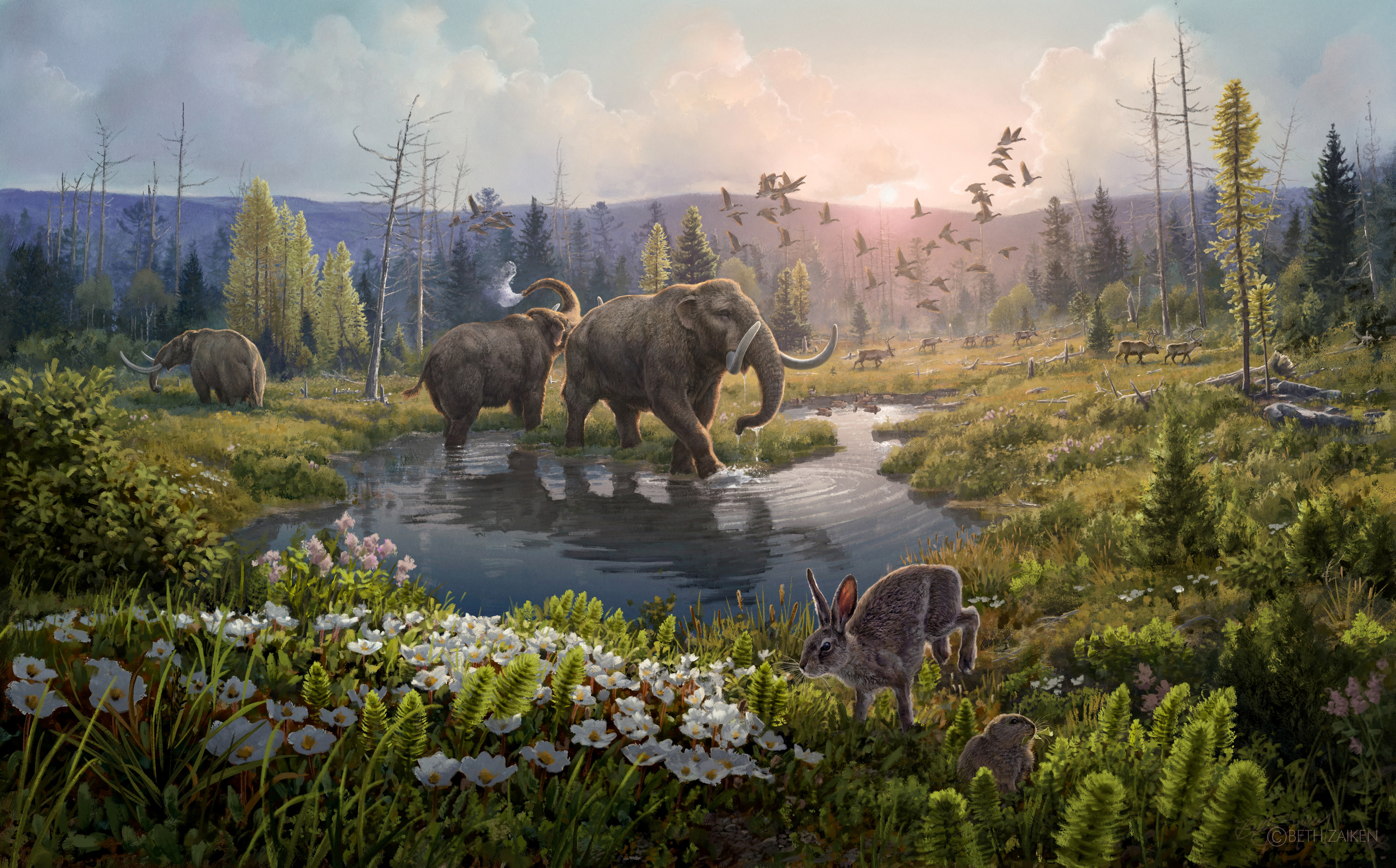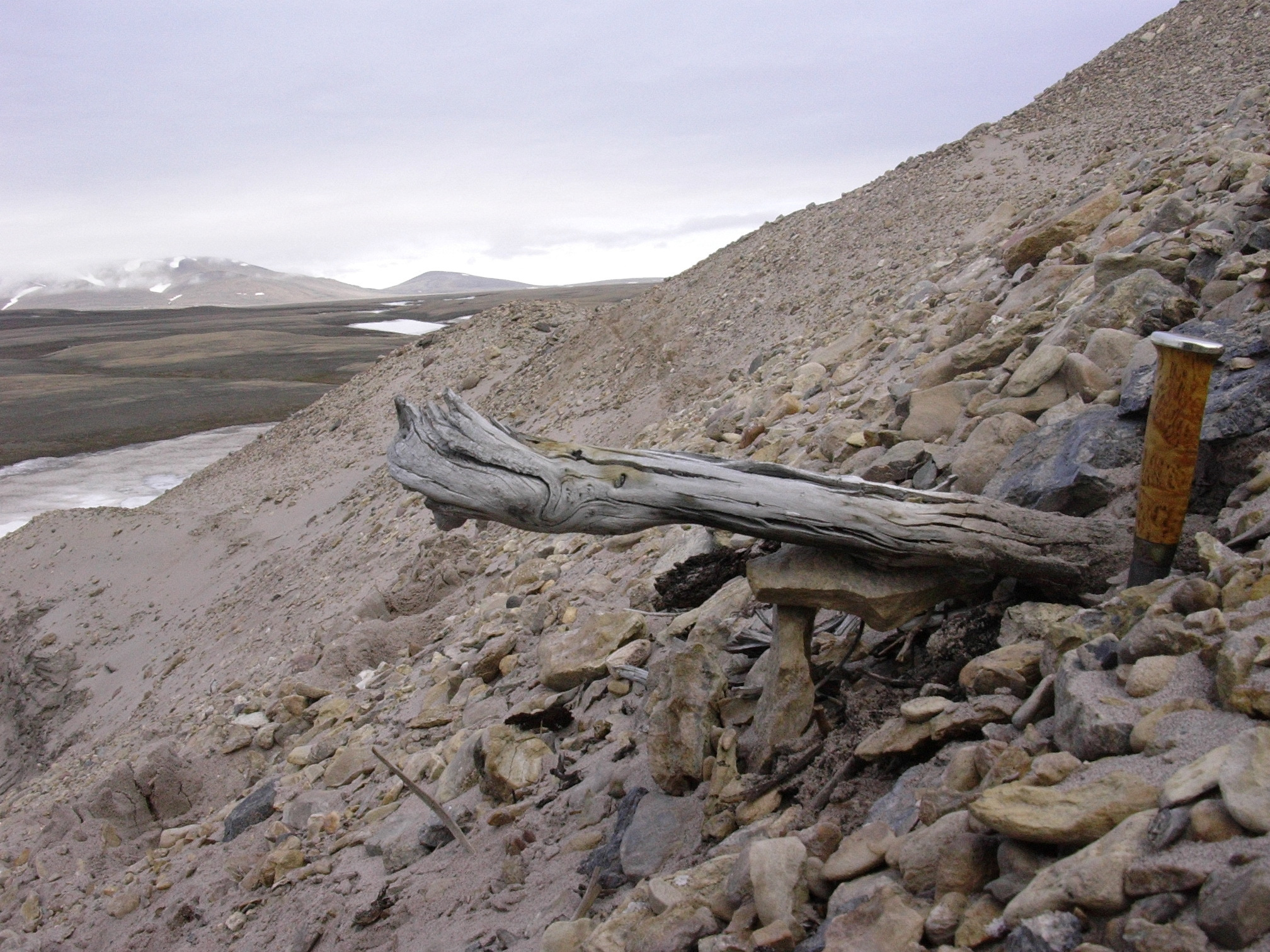Creation ... Extinction
Abstract ... Late Pliocene and Early Pleistocene epochs 3.6 to 0.8 million years ago1 had climates resembling those forecasted under future warming2. Palaeoclimatic records show strong polar amplification with mean annual temperatures of 11–19 °C above contemporary values3,4. The biological communitiesinhabiting the Arctic during this time remain poorly known because fossils are rare5. Here we report an ancient environmental DNA6 (eDNA) record describing the rich plant and animal assemblages of the Kap København Formation in North Greenland, dated to around two million years ago. The record shows an open boreal forest ecosystem with mixed vegetation of poplar, birch and thuja trees, as well as a variety of Arctic and boreal shrubs and herbs, many of which had not previously been detected at the site from macrofossil and pollen records. The DNA record confirms the presence of hare and mitochondrial DNA from animals including mastodons, reindeer, rodents and geese, all ancestral to their present-day and late Pleistocene relatives. The presence of marine species including horseshoe crab and green algae support a warmer climate than today. The reconstructed ecosystem has no modern analogue. The survival of such ancient eDNA probably relates to its binding to mineral surfaces. Our findings open new areas of genetic research, demonstrating that it is possible to track the ecology and evolution of biological communities from two million years ago using ancient eDNA.A 2-million-year-old ecosystem in Greenland uncovered by environmental DNA Kurt H. Kjaer, Nature
"The study opens the door into a past that has basically been lost.""[The samples came from a sediment deposit called the Kap København formation in Peary Land. Today, the area is a polar desert.]"Kurt Kjaer, geologist, glacier expert, University of Copenhagen"I wouldn't have, in a million years, expected to find mastodons in northern Greenland.""I wouldn't be surprised if you can go at least one or perhaps a few million years further back, assuming you can find the right samples."Love Dalen, researcher in evolutionary genomics, Stockholm University"You really get a broader picture of the ecosystem at a particular time.""You don't have to go and find this piece of wood to study this plant, and this bone to study this mammoth."Benjamin Vernot, ancient DNA researcher, Max Planck Institute for Evolutionary Anthropology, Germany
 |
| An artist's reconstruction shows the Kap Kobenhavn formation in northernmost Greenland two million years ago, at a time when temperatures were significantly higher than northernmost Greenland today, in this undated handout image obtained by Reuters on December 6, 2022. Beth Zaiken/Handout via REUTERS |
A team of scientists have discovered the oldest known DNA, using it to interpret what life had been present two million years earlier on the northern tip of Greenland, a barren Arctic desert, which at the time they have revealed, at an ancient period of Earth's evolution, was a green landscape of trees and vegetation. A wide array of animals were present at that time, the now-extinct mastodon among them.
The researchers took to extracting environmental DNA -- eDNA -- in a barren landscape where remnants of animals and vegetation that once flourished in a far different atmosphere millions of years ago left next-to-nothing for posterity in the form of bone shards or a rare piece of woody material. It was from samples of soil that the eDNA emerged for study; genetic material shed by living organisms into their surroundings, from hair, waste, spit or carcasses in decomposition.
Genetic material breaks down gradually over lengthy periods of time and what is left for scientists to examine and extract information from represents fragments of a whole. Advanced technology has allowed researchers to obtain genetic information from small bits of DNA, explained senior paper author Eske Willerslev, a geneticist at the University of Cambridge.
Published in the journal Nature, the study compared the DNA to that of various species. In the search for matches, the samples emerging from a sediment deposit identified as the Kap Kebenhavn formation in Peary Land.
Millions of years previously the region now a polar desert, was in a period of intense climate change. It was likely that sediment accumulated for tens of thousands of years at the site until the climate cooled and froze into the permafrost the DNA-infused soil the investigators studied. Delicate bits of DNA would have been preserved by the incoming environment awaiting discovery by present-day scientists who began drilling samples in 2006.
At the time of the warm period when average temperatures were 11 to 19 degrees Celsius higher than what pertains at the present, the area was home to an unusual array of plant and animal life. The studied DNA fragments speak of an array of Arctic vegetation such as birch trees and willow shrubs including genotypes usually preferring warmer climates such as firs and cedars.
Traces of animals, including geese, hares, reindeer and lemmings were also detected in the studied DNA samples. The unexpected discovery of DNA from a mastodon, an extinct species that resembles an elephant or a mammoth stood out as hugely unusual. Researchers were in addition given clues surrounding marine life from the sediment in the mouth of a fjord -- with DNA pointing to horseshow crabs and green algae in the area, indicating much warmer seas in that long-ago era.
Dr. Willerslev is of the opinion that since these newly-detected plants and animals managed to survive during a time of climatic change, their DNA could present a "genetic road map" to assist environmental science in learning how best to adapt to the warming climate scenario that scientists have alerted the world to, at the present time.
 |
| A two million-year-old trunk from a larch tree, still stuck in the permafrost within coastal deposits at the northern tip of Greenland, is seen in this undated handout photograph obtained by Reuters on December 6, 2022. The tree was carried to the sea by the rivers that eroded the former forested landscape. Svend Funder/Handout via REUTERS |
Labels: Animal and Plant Life, eDNA, Greenland, Paleo Archaeology, Research

0 Comments:
Post a Comment
<< Home